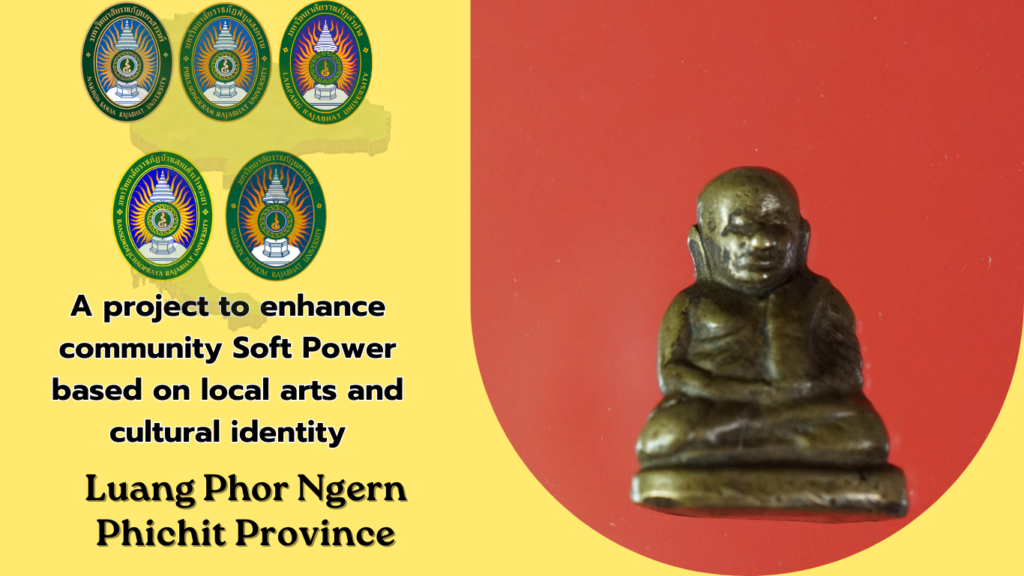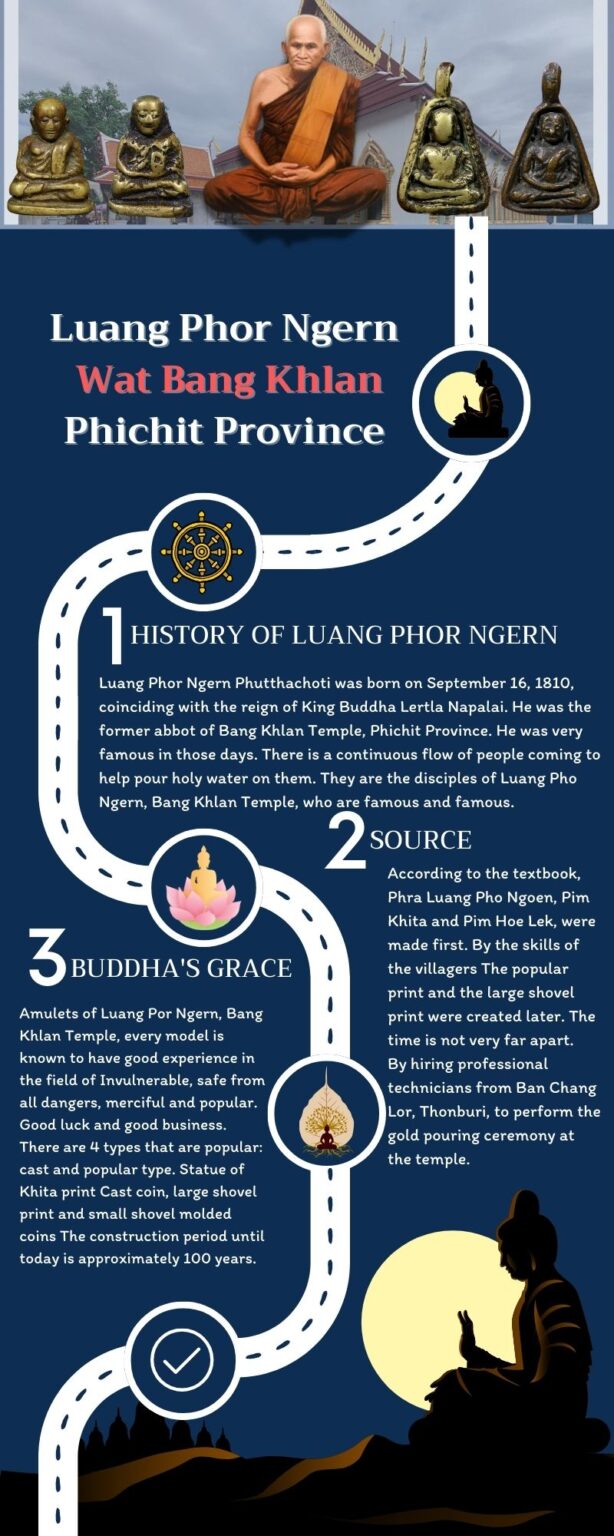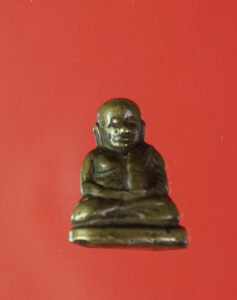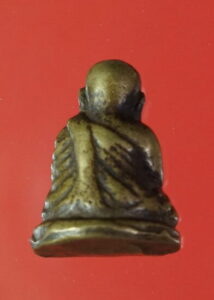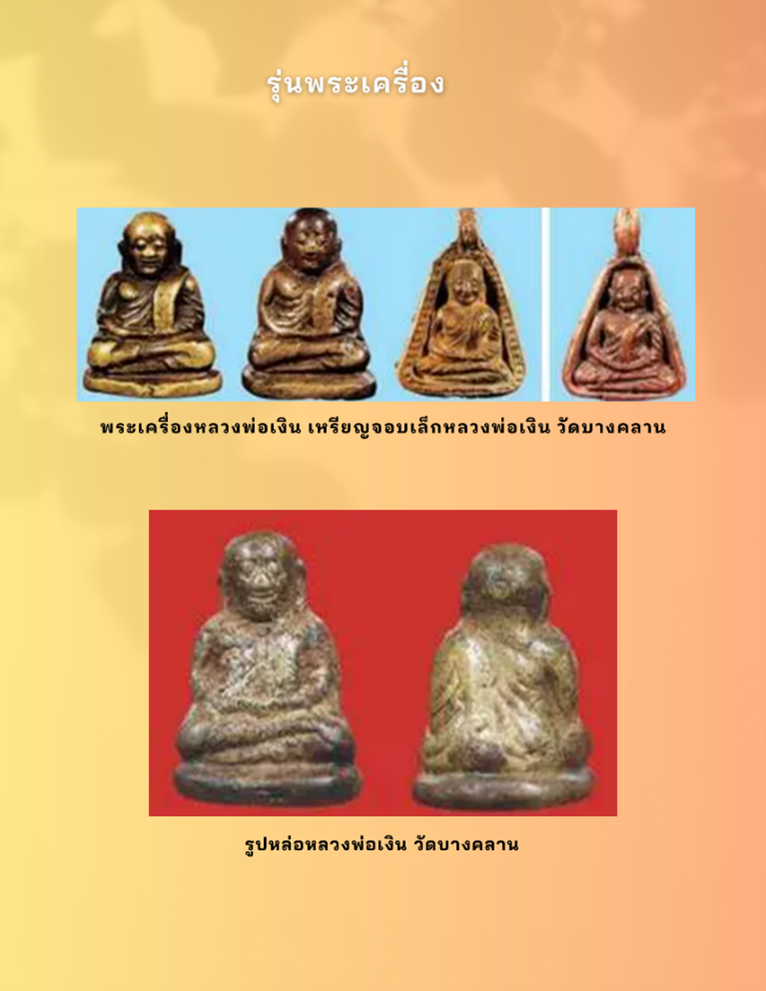The Sacred Power and Legend of Luang Por Ngoen
Luang Por Ngoen of Wat Bangklan possessed the extraordinary ability to perceive the thoughts and intentions of those who visited him through his mystical insight. He was also highly skilled in healing various illnesses and ailments of the villagers.
There was an instance where someone tried to challenge him by shooting at him, but despite the gun being fired, the bullet did not leave the barrel. This miraculous event enhanced Luang Por Ngoen’s legendary reputation far and wide. It was even reported that “Prince Chumphon Khet Udomsak” (a royal figure) visited him to become his disciple.
Luang Por Ngoen passed away on Friday, September 20, 1919, at the age of 111 years and having spent 90 years as a monk. He passed at Wat Wang Tako, in the Bangklan district of Phichit province. He left behind a legacy full of miraculous stories.
The amulets of Luang Por Ngoen from Wat Bangklan are highly valued, with prices for those in good condition reaching millions. It is now rare to find authentic amulets of his. His sacred power is especially renowned for protection from harm, survival in dangerous situations, and bringing good fortune.
In the past, Phichit had many robbers, and the village leaders always carried Luang Por Ngoen’s amulets for protection. There was a famous case where a village headman and his wife, who was driving the car, were ambushed by robbers. Miraculously, they survived the attack without a scratch, despite the bullets being fired at them.
In 1972, the temple created a batch of Luang Por Ngoen amulets, performing a special ceremony on three separate occasions. During this event, miraculous phenomena occurred, such as the sun being surrounded by a halo and Rahu (an astrological phenomenon) obscuring the sun. As a result, the Luang Por Ngoen amulet from 1972 became famous very quickly, with its price soaring to hundreds of thousands and even millions.
The Chant for Worshiping Luang Por Ngoen of Wat Bangklan
To be recited every morning:
First, recite “Namo Tassa” three times, then focus the mind and chant the following:
Siddhi Bhutthang Kitchang Ma Ma, Phu Khon Lai Ma, Na Chalee Ti
Siddhi Dhammang Chittang Ma Ma, Khao Khong Lai Ma, Na Chalee Ti
Siddhi Sangkhang Chittang Ma Ma, Ngern Tong Lai Ma, Na Chalee Ti
Chim Phlee Mahaa Lapang, Phawandume
On the days of worship—Tuesday, Thursday, and Friday—offer nine lotus flowers or jasmine blossoms, three betel nuts, and place them in a tray along with nine incense sticks and a pair of candles. Focus your intention and pray for the blessings of Luang Por Ngoen, seeking his protection from thieves and dangers, as well as prosperity in business and favorable fortune.
The sacred power of Luang Por Ngoen, particularly in his amulets, such as the standing statue of Luang Por Ngoen, the popular and “eye booger” mold, the egg-shaped amulet with a hoe design, small hoe-shaped amulets, the Takrut (magical scroll), and the holy water, are widely known and revered. His mystical powers and miracles are numerous and will be shared in further detail.
Luang Por Ngoen’s Chant for Invulnerability (Kong Grapan)
Phra Phutthang Phra Chao Kong Nang
Phra Dhammaang Phra Chao Kong Neua
Phra Sangkhang Phra Chao Kong Kraduk
Om Phet Khong Kha Tri Khong Swaha
This chant is used for invoking protection and invulnerability, particularly for safeguarding oneself from harm or injury. It focuses on the strength of the Buddha, Dhamma, and Sangha to protect the body, ensuring that the skin, flesh, and bones remain unharmed. The final part invokes the power of the sacred diamond and the Trikong (a form of magical protection).
The origin of this chant is said to be from Savatthi.
There were an elderly couple who made their living by fishing all their lives but had never done any good deeds. One day, the Buddha, through his divine knowledge, knew that the elderly couple had once offered sangkhatan (monastic offerings) to the Buddha, Phra Buddha Tanhakang, but they had also embezzled the money during the time of Phra Buddha Methakang. As a result, they had to suffer for many lifetimes.
The Buddha saw that the elderly couple would die within 7 days and decided to teach them how to meditate so that they wouldn’t go to hell. The Buddha went to visit the couple and, upon arriving, radiated his divine light, which caused the couple to feel reverence and faith. They offered food to the Buddha, and the Buddha asked if they wanted to be wealthy. The couple said yes, and the Buddha told them he would give them a mantra that would make them rich, but they must chant it and not catch any fish. The couple agreed and began chanting the mantra:
“Phutto, Kammatthamo, Kammma Chuti, Sampudtho”.
They chanted the mantra for 7 days, and then both of them passed away. The Lord of Death, Yama, came to collect their souls. However, the chant they had done before their death caused their spirits to hold on to the mantra throughout the journey. When they arrived at Yama’s court, the judge read their good and bad deeds and called upon the shrimp, fish, and turtles that the couple had killed to testify. Remarkably, none of the animals came forward except for a turtle, which said, “These two have been chanting the mantra with compassion, asking for forgiveness. I do not hold a grudge against them and forgive them.”
The Lord of Death, Yama, then descended from his throne and declared, “There are no grievances against them. The offerings they made to the Buddha led them here.” The couple was surprised, wondering how, despite all the fish, shrimp, and turtles they had killed, they ended up in heaven. Yama explained that the Buddha they had met was no ordinary person; he was the Buddha, and the mantra they had been chanting was a form of meditation for compassion and forgiveness. The mantra helped them avoid falling into hell and led them to the realm of Chattumaharajika (the Heaven of the Four Great Kings).
Later, Phra Mokkallana, an enlightened monk, encountered two heavenly beings who told him about the couple’s mantra. He then passed on this teaching to Phra Kru Yai of Wat Mueang Phichit, which was later passed on to Ajarn Somdet Phra Phutthajarn (To) and Phra Luang Phor Ngern of Wat Bang Klan, where it was preserved and continued.
The History of Popular Amulets: The History of Luang Por Ngoen of Wat Bangklan
The Luang Por Ngoen amulet from Wat Bangklan, which is highly popular, comes in four distinct designs: the standard form, the “eye crust” form, the large hoe-shaped coin, and the small hoe-shaped coin. These amulets are approximately 100 years old, making them quite antique. According to records, the “eye crust” form and the “small hoe” form were created first by the local villagers, while the standard form and the large hoe-shaped coin were made later, though not much later, by professional artisans hired from the Thonburi casting village. The casting ceremony took place either at the temple or at the casting village (there are differing accounts).
For the “eye crust” form, there are three notable points of interest that should be studied: 1) there is a piece of flesh located beneath the left eye, 2) there are three lines of robes, with the bottom line being thick and slanted from the chest to the right arm, and 3) the robe line on the left arm is inverted. Additionally, the sanghati (monk’s outer robe) is curved and raised, not flat.
